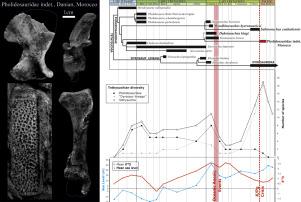当前位置:
X-MOL 学术
›
Gondwana Res.
›
论文详情
Our official English website, www.x-mol.net, welcomes your
feedback! (Note: you will need to create a separate account there.)
Paleocene resurrection of a crocodylomorph taxon: Biotic crises, climatic and sea level fluctuations
Gondwana Research ( IF 7.2 ) Pub Date : 2020-09-01 , DOI: 10.1016/j.gr.2020.03.010 Stéphane Jouve , Nour-Eddine Jalil
Gondwana Research ( IF 7.2 ) Pub Date : 2020-09-01 , DOI: 10.1016/j.gr.2020.03.010 Stéphane Jouve , Nour-Eddine Jalil

|
Abstract Postcranial material of a crocodylomorph from the Danian of Oulad Abdoun Basin (Morocco) is described. Several characters, in particular the shape of its dorsal osteoderms, allows its attribution to Pholidosauridae. Up till now, the latest known pholidosaurid was Terminonaris, from the Early Turonian of North America, so, the Moroccan pholidosaurid extends the stratigraphic range of the group to more than 20 million years younger, and shows that the pholidosaurids survived the K-Pg crisis. The reevaluation and the phylogenetic analysis of Dakotasuchus kingi, Woodbinesuchus byersmauricei, and Sabinosuchus coahuilensis, previously considered as goniopholidids and dyrosaurid, respectively, revealed rather that they are pholidosaurids. This analysis also suggests that at least two independent pholidosaurid lineages reached the Maastrichtian, among which one crossed the K-Pg boundary. This study proposes the first analysis of tethysuchian diversity from the Late Jurassic to the Early Paleogene. Two diversity peaks are observed during the Oxfordian and Cenomanian, two stages of high paleotemperatures evaluated with the δ18O. The tethysuchian diversity strongly decreases after the Cenomanian, a decline that may be correlated with the “Ocean Anoxic Event” (OAE 2), which caused the strong marine faunal turnover during the Cenomanian-Turonian time interval. The large Turonian-Coniacian oceanic regression could also be a factor in the tethysuchian decline. After that, tethysuchian diversity remains low until the Maastrichtian-lower Paleocene marine tethysuchian dyrosaurid diversification, correlated with the Late Cretaceous-Paleocene transgression. At least one pholidosaurid lineage crossed the K-Pg boundary, confirming the weak impact of this crisis on the crocodylomorphs. Pholidosaurids seem to go extinct at the beginning of the Paleocene, possibly due to the strong radiation of dyrosaurids in marine environments and crocodylians in fresh-water during this time period.
中文翻译:

鳄鱼形分类群的古新世复活:生物危机、气候和海平面波动
摘要 描述了来自 Oulad Abdoun 盆地(摩洛哥)大年的鳄鱼类的颅后材料。几个特征,特别是其背部骨皮的形状,使其归属于黄龙科。迄今为止,已知的最新的蝶龙科是来自北美洲土伦纪早期的 Terminonaris,因此,摩洛哥的蝶龙科将本群的地层范围扩大到年轻了 2000 万年以上,表明蝶龙科在 K-Pg 危机中幸存. Dakotasuchus kingi、Woodbinesuchus byersmauricei 和 Sabinosuchus coahuilensis 的重新评估和系统发育分析,以前分别被认为是分布角龙科和强龙科,结果表明它们是 pholidosaurids。这一分析还表明,至少有两个独立的金龙科谱系到达了马斯特里赫特,其中一个跨越了K-Pg边界。这项研究提出了对晚侏罗世到早古近纪的特提鳄科动物多样性的首次分析。在牛津阶和森诺曼阶期间观察到两个多样性峰值,这是用 δ18O 评估的两个高古温度阶段。在森诺曼阶之后,特提鳄的多样性急剧下降,这种下降可能与“海洋缺氧事件”(OAE 2)有关,后者导致了森诺曼阶-土伦阶时间间隔内强烈的海洋动物群更新。大的Turonian-Coniacian海洋回归也可能是tethysuchian下降的一个因素。在那之后,直到马斯特里赫特 - 下古新世海洋特提鳄科恐龙多样化,与晚白垩世 - 古新世海侵相关,特提鳄的多样性仍然很低。至少有一个 pholidosaurid 谱系跨越了 K-Pg 边界,证实了这次危机对鳄鱼类动物的微弱影响。灰龙科似乎在古新世开始就灭绝了,这可能是由于这一时期海洋环境中的霸王龙和淡水中的鳄鱼的强烈辐射所致。
更新日期:2020-09-01
中文翻译:

鳄鱼形分类群的古新世复活:生物危机、气候和海平面波动
摘要 描述了来自 Oulad Abdoun 盆地(摩洛哥)大年的鳄鱼类的颅后材料。几个特征,特别是其背部骨皮的形状,使其归属于黄龙科。迄今为止,已知的最新的蝶龙科是来自北美洲土伦纪早期的 Terminonaris,因此,摩洛哥的蝶龙科将本群的地层范围扩大到年轻了 2000 万年以上,表明蝶龙科在 K-Pg 危机中幸存. Dakotasuchus kingi、Woodbinesuchus byersmauricei 和 Sabinosuchus coahuilensis 的重新评估和系统发育分析,以前分别被认为是分布角龙科和强龙科,结果表明它们是 pholidosaurids。这一分析还表明,至少有两个独立的金龙科谱系到达了马斯特里赫特,其中一个跨越了K-Pg边界。这项研究提出了对晚侏罗世到早古近纪的特提鳄科动物多样性的首次分析。在牛津阶和森诺曼阶期间观察到两个多样性峰值,这是用 δ18O 评估的两个高古温度阶段。在森诺曼阶之后,特提鳄的多样性急剧下降,这种下降可能与“海洋缺氧事件”(OAE 2)有关,后者导致了森诺曼阶-土伦阶时间间隔内强烈的海洋动物群更新。大的Turonian-Coniacian海洋回归也可能是tethysuchian下降的一个因素。在那之后,直到马斯特里赫特 - 下古新世海洋特提鳄科恐龙多样化,与晚白垩世 - 古新世海侵相关,特提鳄的多样性仍然很低。至少有一个 pholidosaurid 谱系跨越了 K-Pg 边界,证实了这次危机对鳄鱼类动物的微弱影响。灰龙科似乎在古新世开始就灭绝了,这可能是由于这一时期海洋环境中的霸王龙和淡水中的鳄鱼的强烈辐射所致。









































 京公网安备 11010802027423号
京公网安备 11010802027423号